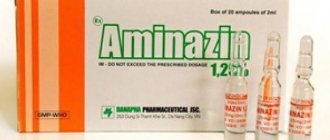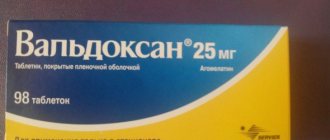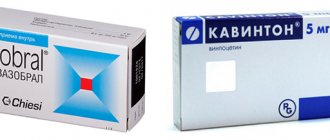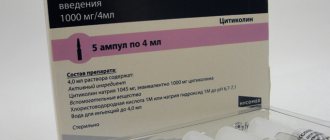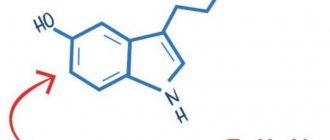General information about the drug Calixta
Calixta is a psychotropic drug that belongs to the group of antidepressant medications. INN – Mirtazapine. The main indication noted in the official instructions is depression of varying degrees of severity.
Forms of release and cost
Calixta is manufactured in the form of oblong tablets with the main component – mirtazapine. The tablets are coated in different shades. The color of the shell depends on the dosage of the active component:
- yellow shell – mirzapine dosage 15 mg;
- pink-brown tablets – dosage 30 mg;
- white – 45 mg.
Tablets with 15 mg of active substance are packaged in blisters (30 pieces in one blister). There is 1 blister in a cardboard box along with the annotation.
Tablets with a dosage of 30 mg and 45 mg are packaged in 15 pieces in a blister, in a cardboard package there are 2 blisters and instructions for using the medication.
Average cost of Calixta in the Russian Federation:
| Number of tablets in a pack | Dosage of the main component (mg) | average price | Name of pharmacy chain |
| 30 | 30 | 962 | E Pharmacy |
| 30 | 30 | 948 | Zdrav-City |
| 30 | 30 | 912 | Europharm |
Compound
The main active ingredient of the drug is Mirtazapine, 15, 30 or 45 mg in one tablet.
Additional Ingredients:
- lactose;
- corn starch;
- hyprolose;
- MCC;
- talc;
- magnesium stearate;
- silica.
The shell contains dye in different dosages, as well as hypromellose and macrogol 600.
Pharmacodynamics and pharmacokinetics
Mirtazapine is an antagonist of presynaptic adrenaline receptors in the central nervous system. The component enhances the transmission of impulses of noradrenergic and serotonergic types in nerve fibers.
The sedative effect of mirtazapine is due to inhibition of histamine H1 receptors. Mirtazapine is well tolerated by the patient, and in therapeutic dosages does not block choline receptors and does not affect the blood flow system and myocardial function.
The pharmacokinetics of the drug Calixta is as follows:
- absorption of the active component in the gastrointestinal tract is high;
- bioavailability – 50%;
- the maximum concentration in the blood plasma is diagnosed 120 minutes after taking the tablet;
- binding to plasma protein compounds – 85%;
- metabolism occurs in liver cells;
- dimethyl-mirtazapine is the active conjugate;
- the medication is eliminated from the body using the kidneys (with urine) and liver (with feces);
- The half-life of the main component is 20-40 hours.
See also:
Selectra - instructions for use, reviews from patients and doctors, analogues
Oral tablets Calixtus
Instructions for medical use of the drug
Description of pharmacological action
Blocks central presynaptic and postsynaptic alpha2-adrenergic inhibitory receptors, enhances central noradrenergic and serotonergic transmission. It is a strong antagonist of serotonin 5-HT2 and 5-HT3 receptors, and practically does not interact with 5-HT1A and 5-HT1B receptors. Mirtazapine is also a strong histamine H1 receptor antagonist, which is responsible for its sedative effect. Weakly affects alpha1-adrenergic receptors and cholinergic receptors. The effect on peripheral alpha1-adrenergic and muscarinic receptors causes the development of orthostatic hypotension and anticholinergic effects.
Indications for use
Depressive states.
Release form
Film-coated tablets 30 mg; blister 15 cardboard pack 2; Film-coated tablets 45 mg; blister 15 cardboard pack 2;
Pharmacodynamics
It is most effective for depressive conditions with the presence in the clinical picture of symptoms such as inability to experience pleasure and joy, loss of interest (anhedonia), psychomotor retardation, sleep disturbance (especially in the form of early awakenings), weight loss, suicidal thoughts and mood lability. In clinical settings, anxiolytic and hypnotic properties are manifested, so mirtazapine is effective for anxious depression. The antidepressant effect usually develops after 1–2 weeks of treatment.
Pharmacokinetics
It is quickly and completely absorbed after oral administration; food intake has virtually no effect on the speed and completeness of absorption. Cmax is reached after 2 hours, absolute bioavailability is about 50%. Plasma Css is achieved within 5 days and is dose proportional in the dose range of 15–80 mg. At concentrations of 0.01–10 mcg/ml, it is 85% bound to blood proteins. The main routes of biotransformation are demethylation and hydroxylation, followed by conjugation of metabolites with glucuronic acid. Cytochrome P450 isoenzymes CYP2D6 and CYP1A2 are involved in the formation of the 8-hydroxy metabolite of mirtazapine, CYP3A4 is involved in the formation of N-demethylated and N-oxidized metabolites. Some metabolites are pharmacologically active, but their plasma concentrations are very low. Excreted in urine (75% of the dose) and feces (15%). The (−)-enantiomer is excreted 2 times slower than the (+)-enantiomer. T1/2 is 20–40 hours (for men - 26 hours, for women - 37 hours). Mirtazapine clearance is reduced in patients with renal or hepatic impairment.
Use during pregnancy
During pregnancy, it is possible only in cases of extreme necessity (adequate and strictly controlled studies on use in pregnant women have not been conducted). FDA category of effect on the fetus is C. Breastfeeding should be discontinued during treatment (no data on penetration into breast milk).
Contraindications for use
Hypersensitivity, simultaneous use with MAO inhibitors.
Side effects
In a 6-week controlled trial, approximately 16% of 453 patients receiving mirtazapine discontinued treatment due to side effects, compared with 7% of 361 patients receiving placebo. Adverse effects observed in ≥1% of patients associated with treatment discontinuation and considered to be attributable to mirtazapine (i.e., occurring at least 2 times more frequently with mirtazapine compared to placebo) included the following: somnolence 10.4% ( 2.2%), nausea 1.5% (0%). The following are side effects that were observed in short-term (6 weeks) placebo-controlled trials in 1% or more cases and were more frequent than in the placebo group (% incidence in the placebo group is indicated in parentheses). It should be borne in mind that these data cannot be used to predict the occurrence of side effects in routine medical practice, because patient conditions and other factors differ from those that prevailed in clinical trials. The reported incidence of side effects may differ from those obtained by other clinical researchers, but they can provide the clinician with information about the relative contribution of the substance itself and other factors (not related to the drug) to the development of side effects in the population being studied. From the nervous system and sensory organs: drowsiness 54% (18%), asthenia 8% (5%), dizziness 7% (3%), unusual dreams 4% (1%), disturbance of the thinking process 3% (1%) , tremor 2% (1%), confusion 2% (0%). From the gastrointestinal tract: dry mouth 25% (15%), increased appetite 17% (2%), constipation 13% (7%). Other: weight gain 12% (2%), flu-like syndrome 5% (3%), back pain 2% (1%), myalgia 2% (1%), increased urination 2% (1%), peripheral edema 2% (1%), dyspnea 1% (0%). Adverse effects reported in these clinical trials in at least 1% of patients receiving mirtazapine and occurring less frequently than in the placebo group: headache, infection, chest pain, palpitations, tachycardia, orthostatic hypotension, nausea, dyspepsia, diarrhea, flatulence, decreased libido, hypertension, pharyngitis, rhinitis, sweating, amblyopia, tinnitus, taste perversion.
Directions for use and doses
Orally, before bedtime, the initial dose is 15 mg/day, the effective dose is usually 15–45 mg/day. In case of renal and liver failure, the daily dose should be reduced by approximately 1/3. The course of treatment is 4–6 months.
Overdose
Symptoms: lethargy, drowsiness, disorientation, tachycardia, hallucinations, increase or decrease in blood pressure. Treatment: gastric lavage, activated carbon, symptomatic and supportive therapy.
Interactions with other drugs
Strengthens the inhibitory effect of ethanol on the central nervous system and the sedative effect of anxiolytics of the benzodiazepine structure. Should not be used simultaneously with MAO inhibitors and within 2 weeks after their discontinuation. Inducers or inhibitors of metabolic enzymes may alter the concentration of mirtazapine in the blood. In healthy volunteers, the cytochrome P450 inducer phenytoin (200 mg daily) when taken concomitantly with mirtazapine (30 mg daily) increased the clearance of mirtazapine by 2 times, which led to a decrease in plasma concentrations of mirtazapine by 45%. Carbamazepine, a cytochrome P450 inducer (400 mg twice daily), when taken concomitantly with mirtazapine (15 mg twice daily), increased the clearance of mirtazapine by 2 times, which led to a decrease in plasma concentrations of mirtazapine by 60%. If phenytoin, carbamazepine or other inducers of hepatic metabolism (eg rifampicin) are prescribed to patients treated with mirtazapine, an increase in the dose of mirtazapine may be required. Cimetidine, a weak inhibitor of CYP1A2, CYP2D6 and CYP3A4, when administered to healthy volunteers (800 mg twice daily) with mirtazapine (30 mg daily) increased the AUC of mirtazapine at steady state by more than 50%. The dose of mirtazapine may be reduced when concomitant treatment with cimetidine is started or increased when treatment with cimetidine is completed. In healthy volunteers, administration of the potent CYP3A4 inhibitor ketoconazole (200 mg twice daily for 6.5 days) and a single dose of mirtazapine resulted in an increase in mirtazapine Cmax and AUC of approximately 40 and 50%, respectively. Caution is required when mirtazapine is co-administered with strong CYP3A4 inhibitors such as azole antifungals, HIV protease inhibitors, erythromycin and nefazodone. Myelotoxic drugs enhance the manifestations of hematotoxicity of mirtazapine. Mirtazapine (30 mg/day) at steady state caused a small but statistically significant increase in INR in healthy volunteers receiving warfarin. It is recommended to monitor the INR in case of concomitant treatment with warfarin and mirtazapine.
Precautions for use
When prescribing antidepressants to patients with schizophrenia or other psychotic disorders, psychotic symptoms may increase. When treating the depressive phase of bipolar affective psychosis, an inversion of affect with the development of mania may be observed. Given the possibility of suicidal tendencies, only a small number of tablets should be prescribed. Women of reproductive age need to use reliable methods of contraception. During treatment, it is recommended to abstain from drinking alcohol. Caution should be used when prescribing benzodiazepines concomitantly with mirtazapine. Treatment is discontinued by gradually reducing the dose and/or increasing the intervals between doses. Abrupt withdrawal after long-term use can lead to nausea, headaches and a general deterioration in well-being. If jaundice, symptoms of infectious diseases or changes in the blood picture appear, treatment is interrupted. During the treatment period, care must be taken when driving vehicles and engaging in other potentially hazardous activities that require increased concentration and speed of psychomotor reactions.
Storage conditions
At a temperature not exceeding 30 °C. Keep out of the reach of children.
Best before date
24 months
Indications and contraindications for taking Calixta
The drug Calixta is effective in the treatment of depressive conditions with the following symptoms:
- lack of joy in life and loss of interest in it;
- psychomotor retardation;
- disturbance of sleep rhythms;
- emotional overexcitation;
- constant mood swings;
- a sharp decrease in body weight;
- thoughts about suicide.
It is prohibited to use Calixta for the following reasons:
- allergy to the medicinal composition;
- patients with genetic pathologies - lactase deficiency, as well as lactose intolerance;
- children under 18 years of age;
- lactation period and pregnancy.
During pregnancy, a doctor can prescribe medication therapy only if the benefits of treatment for the mother are higher than the risks of developing intrauterine pathologies in the child. For treatment during the lactation period, it is necessary to interrupt feeding and transfer the newborn to artificial formula. The drug is not used in pediatric practice due to insufficient information about the safety of Calixta in this period.
With great caution and dosage adjustments, it is prescribed to patients with the following pathologies:
- epilepsy;
- organic lesions of parts of the brain;
- kidney and liver failure;
- cardiological pathologies - myocardial infarction and ischemia, impaired conduction of cardiac impulses, angina pectoris;
- cerebrovascular pathologies – a history of ischemic stroke;
- hypotension and hypovolemia;
- dependence on medications;
- manias and phobias.
Also prescribed with restrictions for the following disorders in the patient’s body:
- prostate hyperplasia;
- impaired urination;
- angle-closure glaucoma;
- high intraocular pressure;
- diabetes.
See also:
Lerivon - instructions for use, reviews and analogues
Features of the antidepressant
Mirtazapine is a drug that scientists have recognized as one of the best when used in the treatment of depression with several drugs, as it combines well with venlaflaxine, bupropion, and fluoxetine.
The manufacturer does not recommend taking the drug with medications from the MAOI class (monoamine oxidase inhibitors).
Patients react acutely to abrupt withdrawal of mirtazapine (a number of unpleasant symptoms occur), so the drug is discontinued gradually, over 12-14 days.
This medication should not be used with alcohol because serious (life-threatening) health problems may develop.
Prescribing medicine to people whose profession requires acute attention and long-term concentration must be done very carefully and under medical supervision.
Mirtazapine is able to reduce pain associated with migraines, tension headaches, and dorsalgia. Pain relief is achieved due to the ability of the drug to reduce the inhibition of the antinociceptive system, which is affected when exposed to pain impulses.
Taking this antidepressant in old age can reduce anxiety, improve mental functioning, and normalize sleep.
The use of mirtazapine helps stabilize the emotional background during withdrawal syndrome and treatment for alcohol dependence.
A course of mirtazapine reduces the number of panic attacks by half.
The drug is well tolerated by older people.
Treatment with this antidepressant is stopped if, after 6-8 weeks of use, no positive dynamics are observed in the patient’s condition.
The superiority of mirtazapine over other drugs in the treatment of depressive disorders is due to its psychotropic, anxiolytic, sedative and hypnotic properties and better tolerability.
The drug improves mood, relieves anxiety, panic, fears and phobias, normalizes sleep and the autonomic system. And in comparison with Citalopram, Sertraline, Paroxetine, Fluoxetine, taking an antidepressant faster led to the desired result.
Mirtazapine has proven itself well in the treatment of somatoform disorders.
A course of this antidepressant helped get rid of depression (in 50-60% of cases) in patients for whom other drugs did not help.
Practical studies have shown good results from mirtazapine therapy for recurrent mental disorders - the number of exacerbations has been significantly reduced.
Scientists have effectively used this drug to treat depression in people who have had a heart attack, cancer patients, and neurotic patients.
Instructions for use of the drug Calixta
The tablets are taken orally whole, without breaking the protective shell. You need to drink them with enough water.
The daily dosage of Calixta ranges from 15 to 45 mg. The initial dosage is 15 mg or 30 mg, depending on the progression of the pathology. The medicine is taken once a day, but if necessary, the doctor can distribute the daily dosage into 2 doses. The medication must be taken at the same time, and when the dosage is divided into 2 doses, patients take most of the dose the night before going to bed.
The first therapeutic effect from the use of Calixta is noticeable 7-15 days after the start of therapy. The duration of the medication course is 4-6 months or until the severe symptoms of depression completely disappear. After the symptoms of the pathology disappear, the dosage should be reduced gradually over 4 weeks. Treatment with the maximum permissible dose can be carried out for no longer than 1 month.
The instructions indicate that for elderly patients, adjustment of the treatment regimen is not necessary. Increasing the therapeutic dose in elderly patients is carried out only under the supervision of the attending physician.
If there is no positive dynamics in therapy, then stop treatment with this medication and the doctor selects analogues of Calixta or prescribes another treatment regimen. In case of insufficiency of liver and kidney function, dose adjustment is necessary.
Composition, release form and packaging
Yellow , oblong, film-coated tablets
| 1 tab. | |
| mirtazapine | 15 mg |
Excipients: lactose monohydrate – 44.4 mg, corn starch – 28 mg, hyprolose – 15 mg, microcrystalline cellulose – 15 mg, pregelatinized starch – 15 mg, talc – 1.4 mg, magnesium stearate – 0.7 mg, silicon dioxide – 0.5 mg.
Shell composition: hypromellose-5 CPS – 2.4 mg, macrogol 6000 – 0.2 mg, titanium dioxide – 0.25 mg, iron dye yellow oxide (E172) – 0.1 mg, talc – 0.05 mg.
30 pcs. – blisters (1) – cardboard packs.
Possible side effects of Calixta and overdose
With depression, it is very difficult to distinguish the symptoms of a side effect of a drug from the symptoms of the disease. The use of the drug can provoke the following disorders:
- Lymph and hemostasis:
- agranulocytosis and eosinophilia;
- aplastic anemia.
- CNS:
- drowsiness and decreased concentration and attention;
- sedation;
- headache and severe dizziness;
- lethargy;
- tremor and paresthesia;
- fainting;
- convulsions;
- stroke;
- paresthesia of the oral cavity.
- Digestive tract:
- dryness of the oral mucosa and stomatitis;
- nausea, which can provoke a gag reflex;
- diarrhea;
- swelling of the oral mucosa;
- increased transaminases;
- epigastric and abdominal pain.
- Dermatological manifestations:
- rashes on the epidermis and itching;
- hives.
- Musculoskeletal system:
- myalgia and arthralgia;
- painful sensations in the back.
- Metabolism:
- increased appetite;
- overweight.
- Blood flow system and myocardium:
- hypotension;
- bradycardia;
- Psyche:
- nightmares and insomnia;
- confusion and overexcitement;
- hallucinations and agitation;
- mania and thoughts of suicide;
- anxiety and irritability.
Overdose symptoms:
- CNS depression;
- disorientation in space and time;
- tachycardia and cardiac arrhythmia - arrhythmia;
- pressure fluctuations;
- coma and death.
Overdose therapy consists of the following measures:
- rinse the patient’s stomach and rid the body of any remaining medication;
- allow sorbents to be taken in;
- lay the patient horizontally and ensure unhindered air flow to him (open the window, unbutton the shirt collar);
- Call a doctor for resuscitation or symptomatic therapy.
See also:
Fevarin - instructions for use, reviews from patients who took the drug and psychiatrists
Side effects
If we look at previously conducted trials, it follows that the drug caused adverse reactions in an extremely small number of patients. In human subjects, only 16% of the 453 people prescribed mirtazapine had atypical events, which is a small percentage compared with 7% of the 361 people given placebo.
It should be noted that the results obtained during such trials cannot be considered as a basis for making predictions regarding the occurrence of side effects in normal medical practice. This is explained by the fact that in the ongoing clinical trials, conditions were artificially created for the participants, which are often absent in a normal situation.
We suggest you read: How to save an alcoholic
These figures may differ significantly from those that may be obtained from new clinical trials. But they will be able to give specialists more information regarding the impact of the administered substance and other factors on the development of side effects in the study group of patients.
https://www.youtube.com/watch?v=ytpolicyandsafetyru
The conducted research helped experts find out the following. The drug can cause:
- disturbances in the functioning of the nervous system and sensory organs, leading to drowsiness, dizziness, unusual dreams, tremors, and confusion.
- disturbances in the functioning of the gastrointestinal tract, which can manifest as constipation, increased appetite and dry mouth.
- disorders of a different nature - development of dyspnea, peripheral edema, increased urination, myalgia, back pain, flu-like syndrome, weight gain.
Experts do not rule out the possibility of developing other adverse reactions, which may include headaches, rapid heartbeat, nausea, flatulence, decreased libido, sweating, taste distortion, rhinitis, dyspepsia, diarrhea, tachycardia, orthostatic hypotension and other phenomena that may be observed in in rare cases.
Special recommendations for the use of Calixta
When using the drug Calixta in therapy, the following factors must be taken into account:
- In patients with pathologies such as schizophrenia, psychotic symptoms increase when using antidepressants. Paranoid thoughts also increase in such patients;
- the manic-depressive stage of psychosis, when used in the treatment of antidepressants, can go into the manic stage and rapidly progress;
- In patients under 24 years of age, Calixta and other antidepressants may provoke suicidal behavior and become a risk factor for thoughts of suicide. Therefore, before prescribing this medication, it is necessary to weigh all the positive and negative aspects of therapy. Treatment with Calixta must be carried out under the supervision of the attending physician;
- the medication is not addictive, but the medication must be discontinued gradually, reducing the dosage to the minimum, because if Calixta therapy is abruptly discontinued, the patient may develop negative withdrawal symptoms. Such manifestations may be associated with the underlying pathology and cause relapse of depression;
- during treatment with an antidepressant, it is prohibited to drink alcohol and alcohol-containing medications with any percentage of alcohol in them;
- The combined use of Calixta and Erythromycin, antifungal medications, and HIV protease inhibitors is not allowed;
- joint therapy with Cimetidine involves reducing the dosage of Calixta due to an increase in the concentration of the mirtazapine component in the blood;
- At the first symptoms of jaundice development in the body, therapy with this medication must be stopped.
See also:
Cavinton Comforte - instructions for use, reviews, differences and analogues
Interaction with other drugs
https://www.youtube.com/watch?v=ytcopyrightru
Calixta should be prescribed with caution due to the risk of adverse effects resulting from interactions with other drugs. Thus, the drug, when taken with medications containing ethanol, can have a depressing effect on the central nervous system. When treated with anxiolytics of the benzodiazepine structure, the drug has a pronounced sedative effect.
It is not advisable to prescribe the antidepressant Calixta together with MAO inhibitors. You can take it no earlier than two weeks have passed since the end of treatment with MAO inhibitors.
The drug may have a negative effect when used together with inducers or inhibitors of metabolic enzymes, which have the ability to change the concentration of mirtazapine in the blood.
According to the results obtained during observations, in healthy people who took the cytochrome P450 inducer phenytoin along with mirtazapine 30 mg, a twofold increase in the clearance of mirtazapine was noted, due to which their plasma concentration of mirtazapine significantly decreased by 45%.
Carbamazepine, which is an inducer of cytochrome P450, is undesirable for joint use. If it is taken together with mirtazapine, it is possible to double the clearance of mirtazapine, which can have an even more negative effect and cause a decrease in the concentration of the active component in the blood plasma by 60%.
Another drug whose medicinal properties can be negatively affected by Calixta is Cimetidine. It is a weak inhibitor of CYP1A2, CYP2D6 and CYP3A4. It has been proven that when healthy people took this drug along with mirtazapine, an increase in the concentration of the substance by more than 50% was noted.
In people participating in a study of the CYP3A4 inhibitor ketoconazole who were prescribed mirtazapine with this drug, there was an increase in mirtazapine Cmax and AUC of approximately 40% and 50%, respectively.
The drug should be prescribed with caution to patients taking strong CYP3A4 inhibitors, which should primarily include azole antifungals, HIV protease inhibitors, Erythromycin and Nefazadone.
Myelotoxic drugs, which in combination with mirtazapine enhance the manifestation of hematotoxicity of the latter, can have a negative effect on this medication.
Analogues of the drug
Substitutes for the drug Calixta can be structural drugs with mirtazapine, as well as drugs that have other active ingredients, but have the same therapeutic direction. The most popular analogues:
- Paroxetine - the active component of paroxetine, is a therapeutic substitute for Calixta. This medication is prescribed for the treatment of panic disorder, depression of various etiologies and different types - reactive, endogenous, as well as depression with a constant feeling of anxiety;
- structural analogue of Mirtazapine. This antidepressant is prescribed for the following mental pathologies - depression and anxiety, affective disorders and panic, obsessive-compulsive disorder, anorexia with constant nausea and severe vomiting, migraine-like pain and severe headaches with different locations, as well as for patients in the post-traumatic period after brain injury or severe stress;
- structural analogue of Noxibel. The antidepressant enhances adrenergic and serotonergic impulse transmission. The main component in the analogue is mirtazapine. It is prescribed for the following pathologies - anhedonia, insomnia and nightmares, psychomotor retardation, sudden weight loss, thoughts of suicide, paranoid thoughts, anxiety and the development of phobias.
Indications for use
According to the instructions, Mirtazapine Canon is prescribed for the treatment of depressive conditions of various origins. These also include violations that arose against the background of:
- schizophrenia and psychopathy;
- somatic diseases;
- chronic pain syndrome.
The medicine is effective against endogenous and involutional depression, reduced performance and depressed state.
In addition, Mirtazapine Canon 30 mg is prescribed for conditions such as:
- irritability and nervousness;
- suicidal thoughts;
- chronic depression;
- mental disorders;
- obesity associated with nervous breakdown;
- frequent mood changes.
You can also use the drug for chronic fatigue, which is associated with a mild form of depression.
Reviews about the use of Calixta
Reviews about Calixta are mixed both from psychiatrists and from patients. The toxicity of the drug is noted if therapeutic dosages are not observed and taken for a long time, but at the same time, the high effectiveness of the antidepressant and the ability of a short course of medication to restore a normal mental state are also noted.
Doctors
- Kalinyuk Yu.N., psychiatrist: “I prescribe Calixta to patients with severe depression. The medication is part of a complex therapy that reduces the symptoms of anxiety and depression in a short course of 3-4 weeks. More severe forms of depression and depression can be treated for up to six months.”
- Ivanova O.N., psychotherapist: “An excellent drug for the treatment of neurological disorders and sleep disorders. Particularly effective for the treatment of anxiety and depressive disorders in older patients. It is also worth noting the affordable price and high quality of the drug.”
- Dokukin A.G., psychiatrist: “I use it for depressive disorders of various kinds, there are practically no side effects, although in the first days of taking it, lethargy and lethargy are possible. The effect of the drug is determined quite quickly, it is similar to Amitriptyline. The price is quite high, but it is fully justified by the high quality of the drug.”
Similar drugs:
- Miaser Oral tablets
- Life 900 (LIFE 900) Oral tablets
- Heptral Lyophilisate for the preparation of a solution for intramuscular, subconjunctival administration and for instillation into the eye
- Lenuksin Oral tablets
- Heptor (Heptor) Lyophilisate for the preparation of solution for injection
- Prodep Capsule
- Citalopram Oral tablets
- Paroxetine Oral tablets
- Spitomin Tablets
- Deprim forte Capsule
** The Drug Directory is intended for informational purposes only. For more complete information, please refer to the manufacturer's instructions. Do not self-medicate; Before starting to use Calixta, you should consult a doctor. EUROLAB is not responsible for the consequences caused by the use of information posted on the portal. Any information on the site does not replace medical advice and cannot serve as a guarantee of the positive effect of the drug.
Are you interested in the drug Calixta? Do you want to know more detailed information or do you need a doctor's examination? Or do you need an inspection? You can make an appointment with a doctor - the Euro lab is always at your service! The best doctors will examine you, advise you, provide the necessary assistance and make a diagnosis. You can also call a doctor at home . Euro lab clinic is open for you around the clock.
** Attention! The information presented in this medication guide is intended for medical professionals and should not be used as a basis for self-medication. The description of the drug Calixta is provided for informational purposes and is not intended for prescribing treatment without the participation of a doctor. Patients need to consult a specialist!
If you are interested in any other drugs and medications, their descriptions and instructions for use, information about the composition and form of release, indications for use and side effects, methods of use, prices and reviews of drugs, or you have any other questions and suggestions - write to us, we will definitely try to help you.



